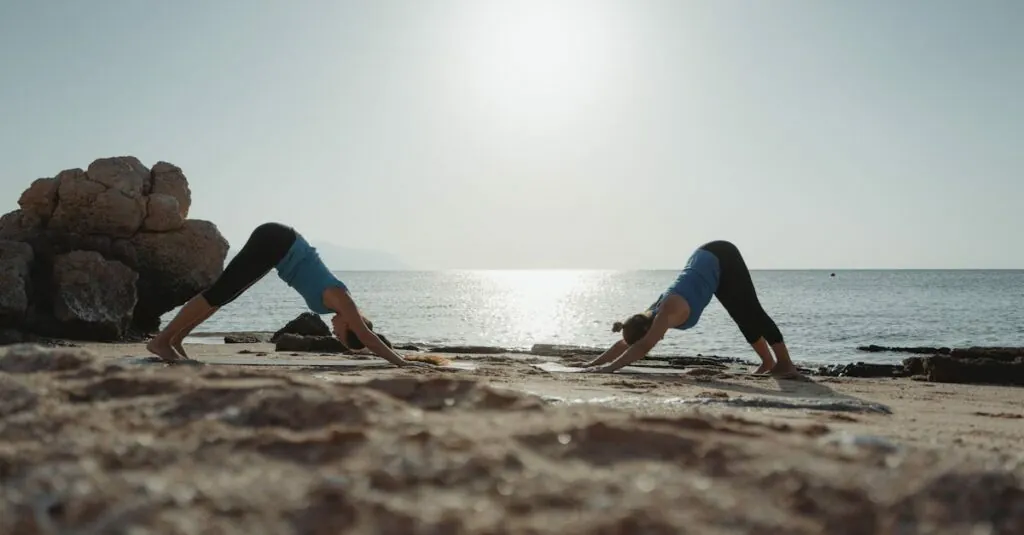Table of Contents
ToggleIn a world that’s always buzzing like a beehive on caffeine, finding a moment of peace can feel like searching for a unicorn. Enter mindfulness exercises—the magical toolkit for anyone looking to calm the chaos. With a handy PDF at your fingertips, you can transform your daily grind into a serene escape, all while avoiding the awkwardness of meditation classes where everyone seems to float on clouds.
Imagine sipping your morning coffee while mastering the art of being present. Mindfulness exercises aren’t just for yogis in flowing robes; they’re for busy bees, too. This guide will show how a few simple techniques can help clear the mental clutter and boost focus. So grab that PDF and get ready to embrace tranquility without the need for a meditation retreat—or a unicorn.
Overview of Mindfulness Exercises
Mindfulness exercises encompass various practices designed to foster present-moment awareness. Techniques such as deep breathing, body scans, and mindful walking serve as effective entry points into mindfulness. Many exercises can be performed in short intervals, making them easy to incorporate into daily life.
Deep breathing exercises typically involve inhaling through the nose and exhaling through the mouth. This simple technique helps reduce stress and calm the mind. Body scans, on the other hand, prompt individuals to focus their attention on different body parts. They encourage relaxation by identifying areas of tension.
Mindful walking encourages individuals to engage with their surroundings. Participants focus on each step, noting sensations in the feet and the rhythm of their breath. Short sessions can deliver noticeable mental clarity, helping individuals appreciate the world around them.
Additional practices, like mindful eating, invite reflection on the flavors, textures, and aromas of food. This exercise enhances the relationship with food, promoting healthier choices and reducing overeating. While each technique offers unique benefits, consistency remains key for optimal results.
Many individuals benefit from using a PDF guide, as it provides structured exercises and reminders. Having a downloadable resource allows easy access to mindfulness practices at any time. Mindfulness exercises can transform everyday moments into opportunities for peace and focus, catering to anyone seeking balance in their lives.
Benefits of Mindfulness Exercises
Mindfulness exercises offer numerous advantages for overall well-being. These benefits extend beyond mental clarity, impacting both mental and physical health.
Mental Health Improvements
Mindfulness exercises significantly reduce symptoms of anxiety and depression. Engaging in practices like deep breathing or body scans encourages a sense of calm and serenity. Regularly practicing these techniques enhances emotional regulation and resilience. Participants report improved focus and a greater capacity for managing stress. Individuals also experience a boost in overall mood, leading to an increased sense of happiness. This mental clarity fosters more productive thought patterns, contributing to greater personal and professional satisfaction.
Physical Health Benefits
Physical health benefits also accompany mindfulness practices. Research shows that individuals who engage in mindfulness experience lower levels of cortisol, the stress hormone. Improved stress management leads to healthier heart rates and reduced blood pressure. Incorporating mindful eating practices contributes to better digestion and nutrition awareness. Furthermore, these exercises promote better sleep patterns, enabling deeper and more restorative rest. Enhanced cognitive function occurs as a result of regular mindfulness, leading to sharper focus and improved physical performance.
Popular Mindfulness Exercises
Mindfulness exercises offer straightforward ways to cultivate present-moment awareness. Here are some effective techniques.
Breathing Techniques
Breathing techniques serve as foundational practices in mindfulness. Individuals can focus on their breath to anchor awareness and reduce stress. One common method involves inhaling deeply through the nose, holding the breath for a few seconds, and exhaling slowly through the mouth. Practicing this for just five minutes promotes relaxation and clarity. Maintaining attention on the breath helps quiet the mind and brings attention back when distractions arise. Integrating these techniques into a daily routine enhances overall well-being.
Body Scan Meditation
Body scan meditation encourages individuals to connect with their physical sensations. Participants lie comfortably and focus attention on different body parts, moving from head to toe. Each section gains awareness as thoughts and tensions are acknowledged and released. This exercise requires around 10 to 20 minutes, making it accessible for daily practice. Observing sensations fosters deep relaxation and enhances body awareness. Regular participation can lead to reduced stress and improved emotional resilience.
Guided Visualization
Guided visualization utilizes imagination to promote relaxation and clarity. In this exercise, individuals follow verbal prompts or recordings that guide them through calming and peaceful imagery. Choosing serene landscapes or tranquil settings can provide a mental escape from daily stressors. Engaging with these visuals stimulates a sense of calm and relaxation, enabling a deeper connection with oneself. Practicing this technique enhances focus and serves as a powerful tool for stress management.
Finding Quality Mindfulness Exercises PDF
Locating high-quality mindfulness exercises in PDF format requires careful attention to details. Start by seeking resources from reputable organizations specializing in mental health and wellness. Websites of institutions like the American Psychological Association and the Mindfulness Research Institute often provide trustworthy materials.
Search for PDFs that offer structured exercises and clear instructions. Well-organized documents typically improve user experience and enable easier application of the exercises in daily life. Look for inclusion of various techniques such as deep breathing, body scans, and mindful walking. Each exercise should provide comprehensive guidance, enhancing understanding and accessibility.
Check for positive reviews or testimonials about the resources. Feedback from other users can indicate the effectiveness of the PDFs. Evaluating credibility by checking author credentials adds another layer of assurance. Professionals in psychology or experienced mindfulness practitioners often produce the most informative content.
Utilize online platforms like Google Scholar for academic-based mindfulness exercises. Academic resources often present rigorous research and evidence-backed practices. Engaging with community forums or mindfulness groups may also lead to valuable recommendations of quality PDFs.
Consider the layout and design of the PDF. Clear organization with headings, bullet points, and visuals enhances usability. Accessible designs facilitate on-the-go reference, making mindfulness practices easier to incorporate into busy schedules. Prioritize PDFs that balance informative content and visual appeal to support learning.
Finding effective mindfulness exercises PDFs demands attention to source credibility, content quality, and usability. By assessing these factors, individuals can seamlessly integrate mindfulness into their daily routines.
Embracing mindfulness exercises can transform daily life into a more peaceful and focused experience. With the right resources such as a well-structured PDF guide, individuals can easily incorporate these practices into their routines. The techniques discussed not only promote mental clarity but also enhance emotional well-being.
By integrating simple exercises like deep breathing and mindful walking, anyone can cultivate a greater sense of awareness and relaxation. As individuals commit to regular practice, they’ll likely notice significant improvements in their overall health. Mindfulness isn’t just a trend; it’s a valuable tool for navigating the complexities of modern life, offering a pathway to tranquility and balance.







